Efficient data centre design achieves 40% cost saving
A data centre in Finland has been designed to operate without mechanical cooling, minimising energy consumption. It is one of the lowest-cost data centres in the world, achieving a 40% saving in construction expenditure.

Yandex is one of Europe’s largest internet companies with a customer base which is expanding outwards from Russia. In a move designed to strengthen its European connections, it planned a new data centre in Finland with five data halls and total IT load of 40MW – its first to be built outside Russia.
Collaborative process helps deliver one of the lowest energy consumption data centres in the world
Royal HaskoningDHV’s Data Centres team was involved in every stage of the project. We helped translate the business case into a design through a collaborative process which explored every conceivable way to simplify the project. Besides low energy, it resulted in one of the lowest-cost high-tech data centres in the world.A special feature is the absence of mechanical cooling or chillers - outdoor air provides cooling for the data centre using an adiabatic system¹. This was made possible through a mixture of design, IT infrastructure and operational adaptations. In close cooperation with the Yandex IT department their development team was capable to optimise the design and operational strategy of their servers, which are designed and built in house.
Throughput of external air avoids the need for mechanical cooling
“This use of direct air from outside in cooling is unusual,” says Martien Arts, Mission Critical Facilities, Royal HaskoningDHV. “We designed a unique structure to facilitate it. The building is angled to face the dominant wind direction. The design, which looks like an aeroplane wing, creates differential air pressures at each end to draw the wind through the building. We designed and tested the shape, as well as the impact of wind, pollution, rain and snow.”A heat exchange system in the data centre connects into the district heating for a nearby village in the southern province of Mäntsälä. The building has an extremely low energy consumption and PUE just above 1.0. We ensured it is fit for purpose, customised for Yandex’s equipment and operations, by challenging the design criteria. The process led to construction costs being significantly reduced to nearly half typical data centre builds.
Next generation data centre design
Based on the success of the Finnish data centre, Yandex asked us to develop a design which could be adapted across Russia, for multiple climate and seismic zones. It needed to offer the capability of operating in extreme heat or cold and to withstand seismic disturbance or heavy snow.
Our modular blueprint was made up of three sections - the data centre, cooling and electrical part. Each can be modified depending on local conditions. Automated design methods enable changes to be made to the parameters quickly and easily. The first centre built using this design approach is in Vladimir in western Russia. Future expansions across Russia are in preparation.
